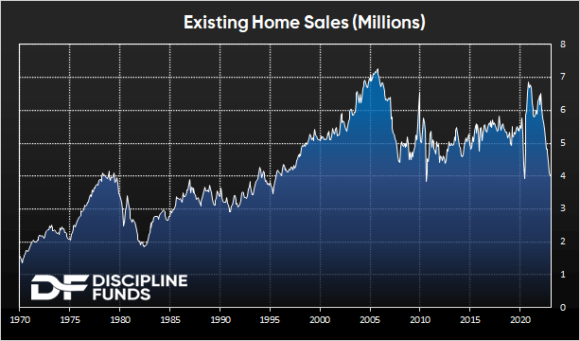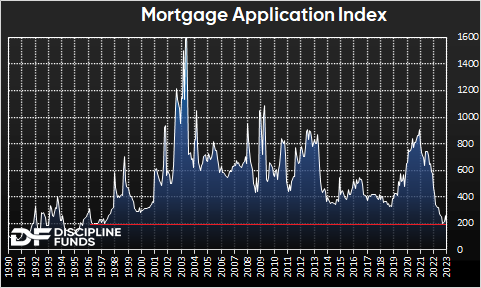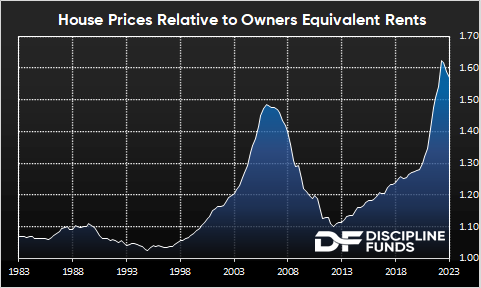There was a glimmer of hope within the housing knowledge from January. The inventory market rallied sharply and there was numerous commentary about how the economic system is headed again to growth time. I’m not so assured and I nonetheless firmly imagine that the “muddle by” situation I discussed in my full yr outlook is the baseline. And I’d argue that the uneven threat to this outlook is to the draw back, not the upside.
Housing is the Economic system.
I hesitate to attribute financial progress completely to at least one sector, however the US housing sector is so giant that it has a disproportionately giant affect on baseline progress. So when housing strikes lots in a single route or the opposite it has a disproportionate affect on mixture progress. This was the fundamental gist of the well-known Ed Leamer paper which was revealed in 2007 earlier than all of us realized this was all too true.
I formally turned bearish on housing in April of 2022. The fundamental gist of my view was that housing costs had grow to be unhinged from fundamentals and rising rates of interest diminished affordability to an extent that might considerably scale back demand. That is trying fairly good as far as home costs peaked final Summer season and all of the housing knowledge has crashed since, however I don’t assume it has totally performed out.
Housing knowledge has turned very unfavourable in latest months. A number of the knowledge is shockingly dangerous. Current house gross sales are at ranges final seen through the COVID low and Nice Monetary Disaster.

It’s tempting to have a look at knowledge like this and assume that it’s nearer to the underside than the highest (which might be a very good factor). Nevertheless it’s arduous to see how this recovers considerably as a result of the affordability problem is the principle driver in housing demand. And housing affordability is nowhere close to the place it must be for demand to return again. We had been reminded of this this morning when the mortgage software knowledge was launched. After a quick respite final month the most recent launch confirmed a brand new low. A low we haven’t seen in virtually 30 years.

That is breathtaking knowledge. However home costs haven’t actually budged all that a lot but. Sure, we’re beginning to see actual indicators of stress in some greater tier markets like San Francisco (the place costs are already off 10%+), but it surely hasn’t been all that broad to this point. But when I had to make use of the previous baseball analogy I’d say we’re in in regards to the 4th inning of this recreation and the pitcher wants reduction.
The affordability equation is a reasonably easy one. Home costs are too excessive relative to mortgage charges. And rents vs home costs are as large as they’ve ever been. So renters who’re excited about shopping for usually tend to preserve renting. And homeowners who need to transfer will hold onto their “golden handcuffs” with a low mortgage till issues change. So we’d like both an enormous adjustment decrease in rates of interest, an enormous decline in costs or the most definitely situation is that we finally get some mixture of the 2.
For perspective, right here’s the lease vs value knowledge. This knowledge is very imply reverting as a result of individuals should dwell someplace and the relative price of renting vs shopping for is without doubt one of the most important drivers in housing demand. We frequently hear that stock is low on this market and which means home costs can’t fall, however this ignores the truth that individuals can select to lease. And the maths on shopping for vs renting at current is fairly black and white – renting is much extra reasonably priced.

Probably the most troubling side of this knowledge is simply scorching out of whack it stays. Rents have elevated considerably in recent times, however home costs haven’t come down a lot. In order that both implies that rents have to maneuver a lot greater or home costs want to return down lots. Or, some combo of the 2.
The issue is that if rents proceed to rise considerably that may bleed into inflation knowledge as a result of shelter is such a big part of inflation metrics. Which suggests the Fed will stay greater for longer. Which implies that demand for housing will stay weak. Then again, many real-time rental metrics are displaying indicators of slowing which might imply that the longer term reversion is most definitely to return from value declines. So it’s arduous to place collectively a situation the place house costs don’t have a come-to-Jesus second in some unspecified time in the future within the coming years. The one query is when?
In fact, the outlier Goldilocks situation in all of that is that inflation crashes decrease in some unspecified time in the future and the Fed is ready to ease charges again as a comfortable touchdown happens. However that doesn’t look very probably any time quickly as mortgage charges are capturing again as much as 7% and the Fed reaffirms their aggressive fee outlook. My baseline outlook for this yr is 3% PCE inflation at year-end. However even in that situation, which is comparatively optimistic, the Fed will stay at or close to 5% charges all yr. In different phrases, mortgage charges aren’t coming down any time quickly until one thing breaks and the Fed backpedals.
Battle the Fed or Battle the Market?
The beginning of 2023 raised an fascinating query. Because the inventory market rallies, house costs stay agency and even homebuilders rallied, it’s important to ask your self whether or not you battle the Fed and stay bullish or battle the market and stay bearish about potential outcomes?
I’ve been saying this for over a yr now, however housing downturns are very lengthy drawn out occasions. There shall be many moments the place it seems like there’s mild on the finish of the tunnel. However I don’t assume we’re there but. Housing is an enormous gradual shifting beast and the fundamental math on affordability nonetheless seems very dreary to me. I’ve a sense we’re going to be speaking about this housing downturn effectively into 2024 and hopefully by then issues have normalized sufficient that we will get again to life as common. Till then, I nonetheless assume it’s prudent to be cautious about how we navigate the present atmosphere.


